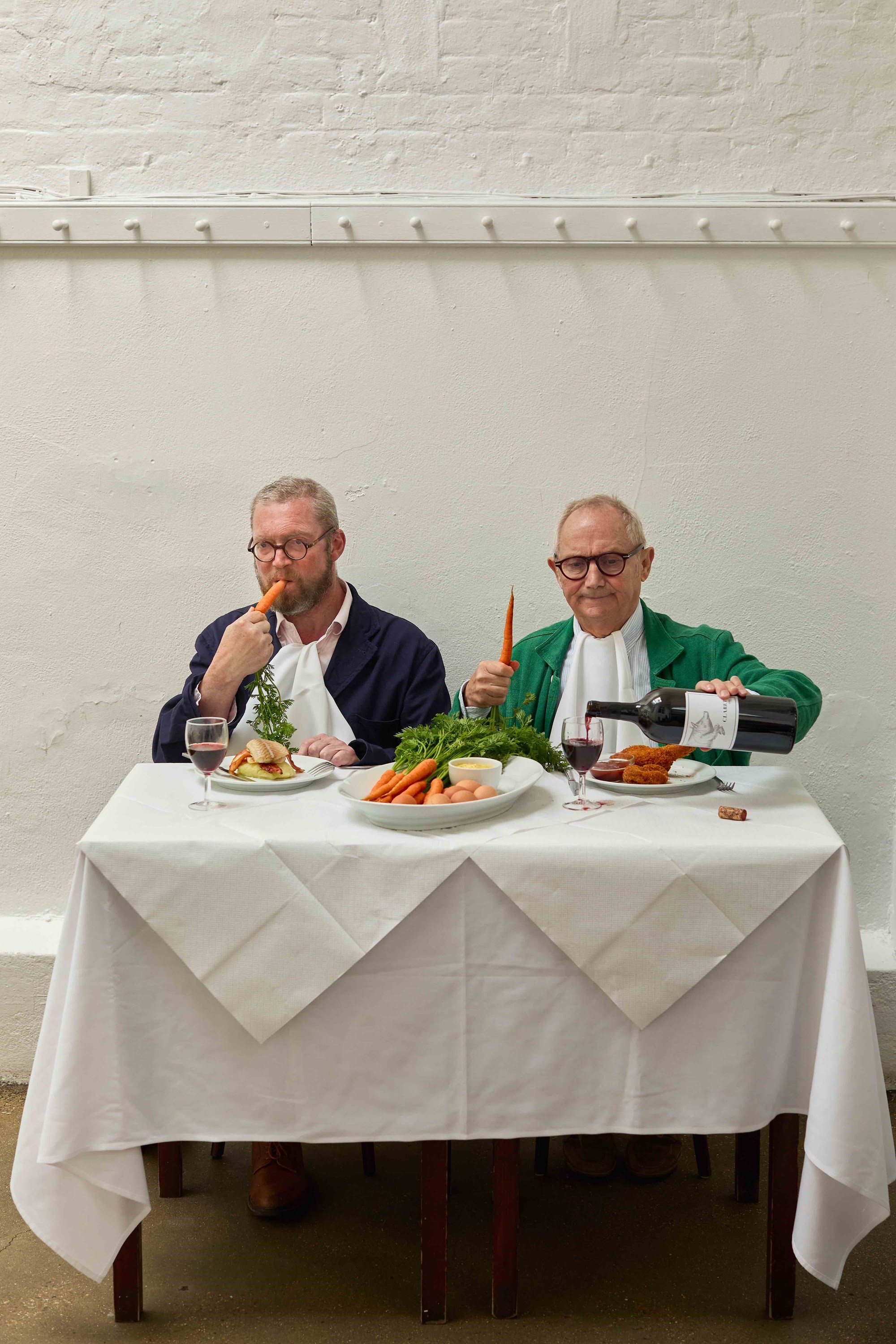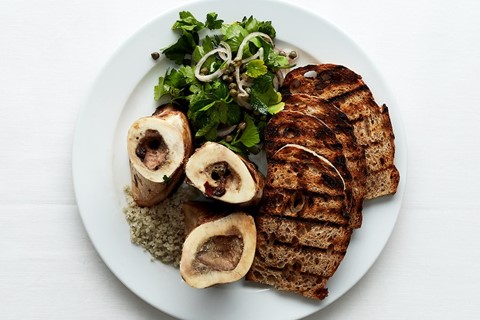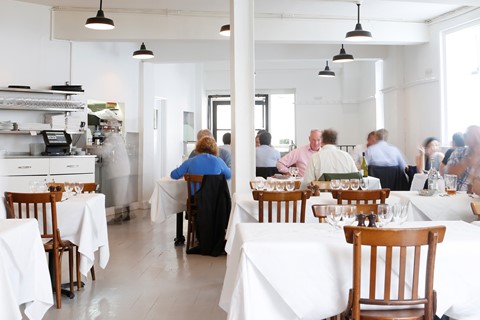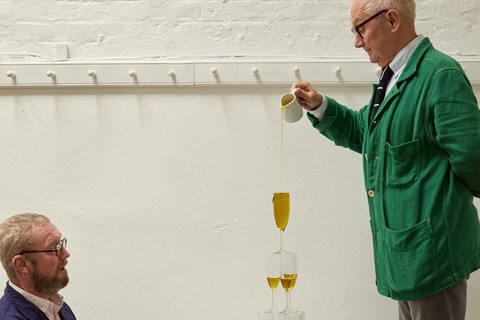‘British food’ is a nebulous category, to be unspooled in the spartan space of St John Smithfield. 30 years ago, Fergus Henderson, Trevor Gulliver and Jon Spiteri opened the east London restaurant in a former smokehouse (it was also once a squat and the Marxism Today office) within the Clerkenwell industrial enclave, opposite the ancient meat market.
While the mid-90s London food scene was obsessed with foams and gold leaf, St John’s menu celebrated simplicity and solid produce, with squidge, jellies, and offal presented on white table cloths. They prized pork when it was beef and duck du jour; there was the now classic and confronting roast bone marrow; smoked cod’s roe, grouse offal, chicken liver, crab meat – all on toast; plates of tripe, crispy fried pig tail, eel, bacon and mash. In the back, they fermented, cured, butchered, and baked – skills largely eschewed in peers’ kitchens.
Soon, everyone from Tracey Emin to Madonna was climbing the iron stairs to dine in the white room. Praise from Anthony Bourdain brought St John’s lore to global audiences who pilgrimage to this day. A heap of radishes with an anchovy dip deeply influenced Noma’s René Redzepi.
St John’s bakery found its home in 2003 beside Spitalfields Market and became Bread & Wine, where snacks given to customers picking up their loaves preceded London’s now-dominant small plates culture. A dedicated bakery opened in Bermondsey in 2010, and another restaurant in Marylebone in 2023. We won’t linger on the short-lived St John Hotel, which shuttered in 2013, or the stuttered plans for St John Los Angeles.
St John recently celebrated its 30th anniversary with a series of instantly sold-out evenings cooking their 1994 menu with 1994 prices (apricots on toast for £3.70, grilled lamb tongues, broad beans and carrots for £8.80). The restaurant’s DNA is imbued in how we dine, rom its nose-to-tail cooking philosophy to alumni who lead the UK’s most formidable kitchens, from Black Axe Mangal’s Lee Tiernan and Bread Ahead’s Justin Gellatly.
Below, a mix of St John alumni and industry figures reflect on the legacy of the restaurant.
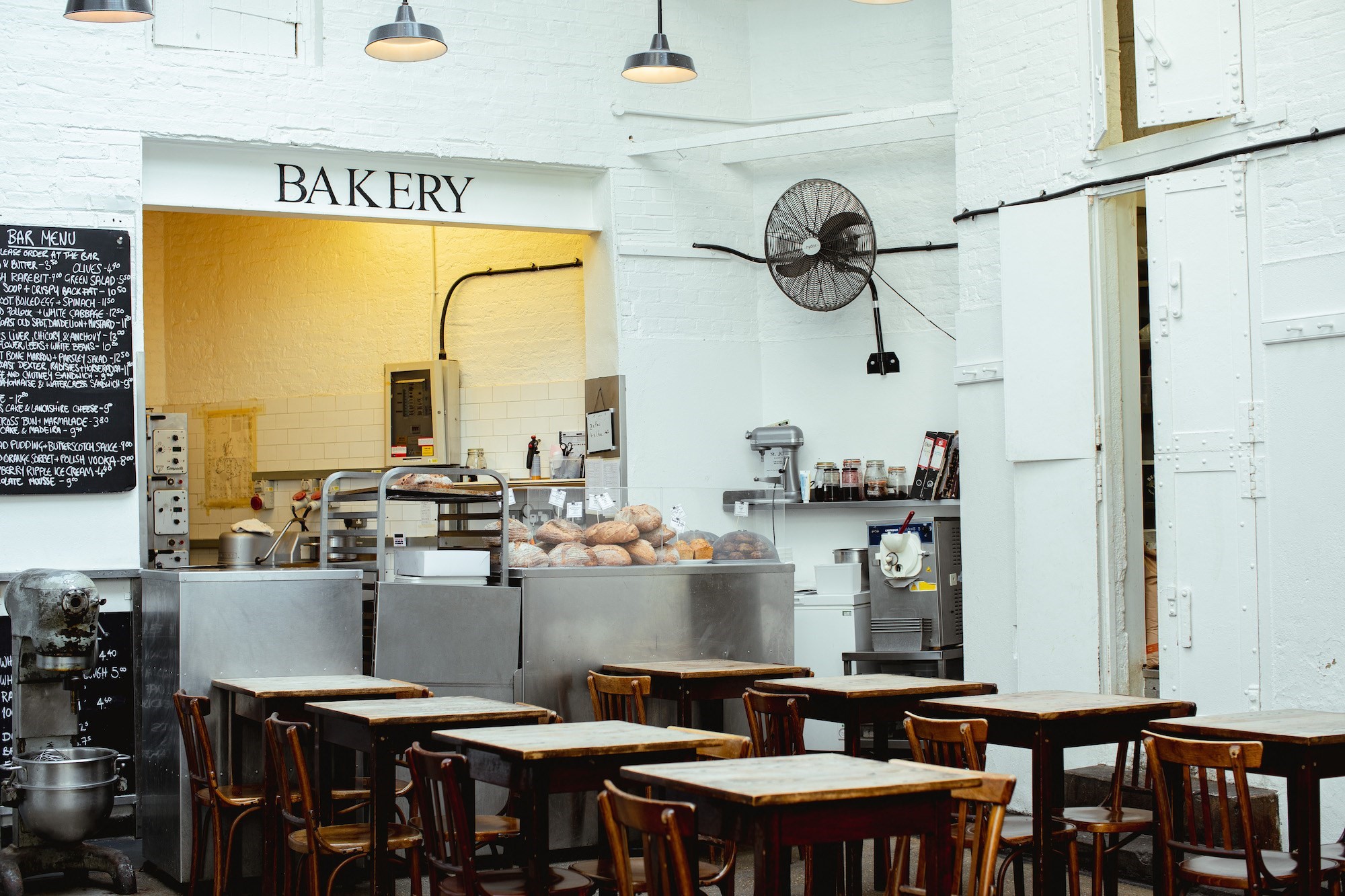
Jeremy Lee, chef and proprietor of Quo Vadis
“Fergus [and I] bonded over our appreciation for a truffle sandwich. It was in the French House that we loved madly – and then of course, to St John. I had just opened a tiny restaurant in Islington, and my dear friend Dan Lepard was baking bread at the new St John Smithfield. We did not open for lunch to begin with, so we popped down every day to pick up this utterly delicious sourdough, treats, and have lunch.
“[I ate] often with Fergus and the jolly crew. I have been restored to life by a glass of Guinness and Welsh rarebit more times than I care to admit. We share a deep love for sitting at a table, breaking bread, and sharing wine. [This is] the simplest, loveliest of bonds.
“Fergus has a wit so sharp, one only hopes a very good Burgundy has been imbibed before the utterance reaches your ear. Aye, I reckon the unerring eye, impeccable taste and unique style of a gentle cook dressed in a suit made of butcher’s cloth, on a path from which he has never strayed, makes Fergus Henderson one of the most important pillars of restaurants the world over, and never more so than within the British Isles.”
“Fergus and I share a deep love for sitting at a table, breaking bread, and sharing wine. [This is] the simplest, loveliest of bonds” – Jeremy Lee
Ravneet Gill, former pastry chef at St John, Countertalk founder
“I would be a different chef had I not entered the pastry kitchen at St John. The ethos for stripping back what’s on the plate and seasonality really makes you consider what you make and why. I enjoyed the ritual of making the daily seed cake, the bread pudding, and learning English classics like spotted dick. The twice-baked chocolate cake is still one of my favourites. I felt very grateful to bring recipes that became Fergus-approved: Paris-Brest, trotter-shaped prune chocolates.
“[For the anniversary party] we made a huge pig-shaped cake filled with damson jam with cake extraordinaire Lily Jones. It was a cake to feed around 400. We decorated the table with a bounty of St John classic bakes – filled doughnuts, Eccles cakes.
“Nice kitchens can exist. You learn, work hard, and enjoy yourself. Everyone felt they were on the same level, which is rare. It was Countertalk’s first inspiration. I wanted to spread the message!”
Nîcolas Payne-Baader, Slop co-founder, former butcher, St John Marylebone front of house
“St John was so supportive when I was starting Slop. It has a knack for attracting interesting people to work there because it’s quite cerebral food with so much philosophy. Everyone knows the ‘nose-to-tail’ thinking, and maybe some people think it’s a bit medieval, but Fergus is so thoughtful. There’s a [George] Orwell essay about the societal lack of memory of food. St John is more than a pig snout on a plate.
“Front-of-house staff get very thorough food briefings before service. The menu changes twice daily, fairly significantly. The fish can often switch halfway through service – ‘that John Dory? It’s brill now!’ It’s demanding but rewarding when you care about produce and storytelling. You’re meeting people doing pilgrimages from all over the world. You get weird dichotomies of customers in one night – Peter Mandelson and Harry Styles, architects of New Labour and pop stars.
“Sometimes we joke that it can be a massive busman’s holiday going to eat when you’ve worked at St John. Half of London’s restaurants are influenced by it – or ripping it off. If St John was to close tomorrow, it would still be the most important restaurant in London for 30 years more.”

Lorcan Spiteri, Caravel co-owner
“I was super young when dad [Jon Spiteri], Fergus and Trevor were opening St John. While they had long lunches it was my playground. I’d have madeleines and doughnuts from the bakers. As a kid, if it wasn’t St John, it was the French House or Rochelle Canteen. I started working for Arnold & Henderson events as a runner – clearing tables, eating scraps from plates. Restaurants were the only option for me.
“I’ve always looked at restaurants through the lens of St John. When I opened Caravel with my brother Finn, it was on my mind. But I go back and forth on whether I want dad’s advice! Two weeks before we opened he said our menu was shit, boring, played out. But we went with our guts and it worked.
“Fergus has always been really supportive of Finn and I. He would come to our pop-ups, our market stall in Soho – he would smash the fried guinea fowl burger – and when we worked at Quo Vadis.
“The St John kidneys are my death row meal – I could do five portions then die off, happily. I remember when I was a kid there was a squirrel special. Surely ... just like chicken.”
“Half of London’s restaurants are influenced by it – or ripping it off. If St John was to close tomorrow, it would still be the most important restaurant in London for 30 years more” – Nîcolas Payne-Baader
Mina Holland, writer and editor, Sol’s Bayswater
“The dishes I love St John for are, perhaps surprisingly, the salads: tomato, anchovy, and little gem; kohlrabi; purple sprouting broccoli vinaigrette. They might have a reputation for bone marrow and offal, but they are magic at meat-free food. I’m now a pescatarian, and there are few places where vegetable-based dishes are as considered and extraordinarily delicious as those for the carnivorously inclined. As someone who struggles with meat industry ethics, it may seem contradictory that I am such a fan. But I believe that if people are going to eat animals, they should not just be consciously sourced, but used in their entirety.
“St John has also quietly just done its thing with wine for years. They champion small producers and regions of France which aren’t necessarily prestigious – although they have lots of that too – but which are always simply delicious. They’ve been doing this since way before the ‘natural wine’ movement. Food and wine are plaited together.”
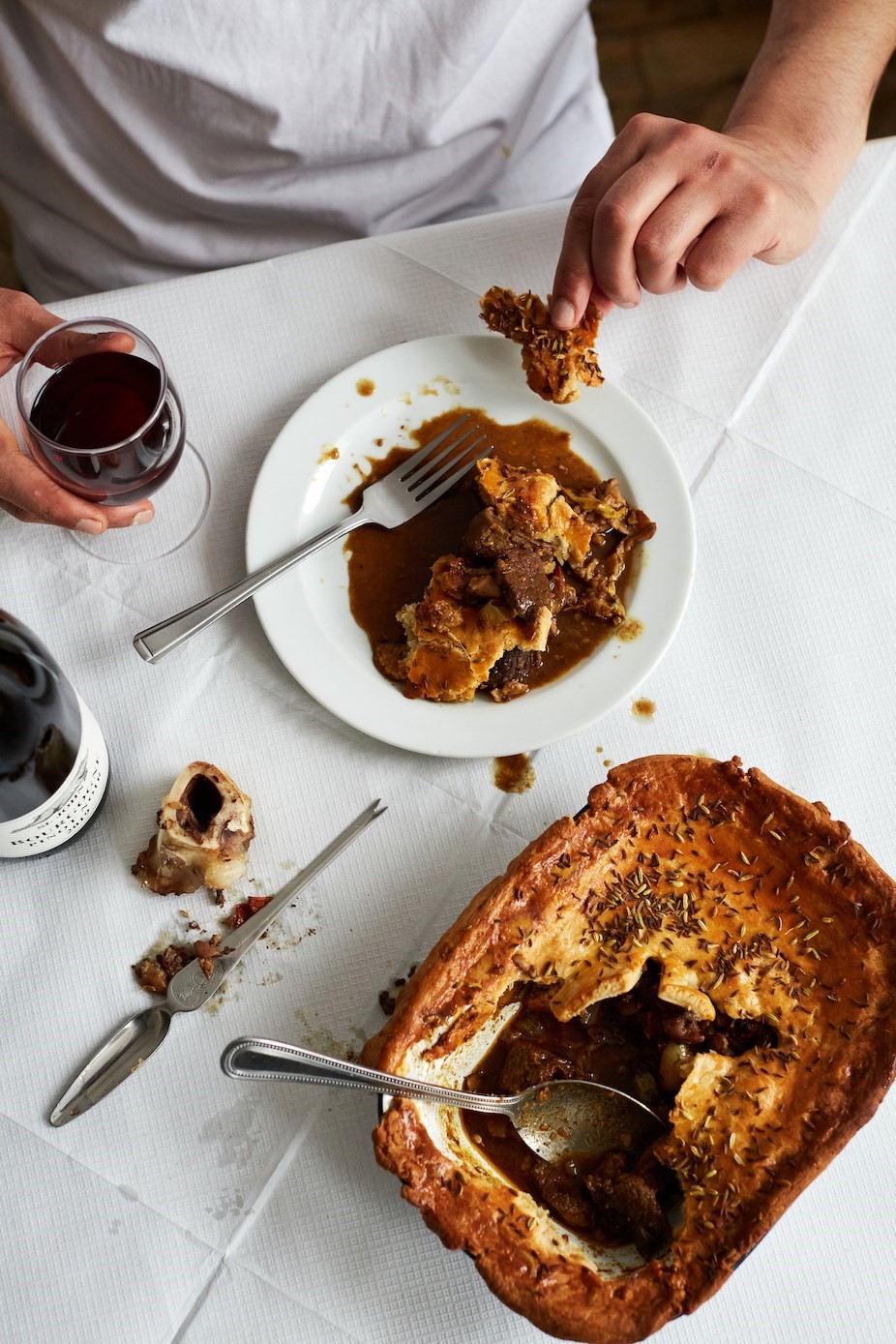
Rose Gabbertas, pastry chef at Lyles, former head of pastry at St John
“I started St John as a stage at age 21. I had no professional kitchen experience but I was a keen cook. I worked under then-head of pastry, Alex Szrok. He was a kind, patient teacher. Coming into a professional kitchen as a young woman, there are a lot of stereotypes, and he expelled all of them. I got to work with the amazing Elliot Hashtroudi, who’s now head chef at Camille. It’s a place that gives you mentors.
“St John supports your classic skills, which can sometimes bypass today’s pastry kitchens. They have no fancy kit. There’s an integrity to the process and an austere way of working that makes you push your creativity and editing.
“St John is truly the best place to be a pastry chef. The dessert menu is often longer than the main menu. It’s printed on the same paper, so dessert is never an afterthought. In the past, there was chocolate and blood pudding. I got to put things on the menu that you wouldn’t be able to anywhere else – wacky, suet-filled, heavy, strange, old-fashioned. I developed regional cooking techniques and dug into historical recipes. I served carrageen pudding, a set dessert with seaweed, and Yorkshire curd tart that predates cheesecake using cow’s curd. Very ye olde! Everyone knows Fergus loves dessert.”
Find out more about St John here.
